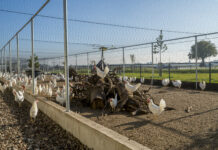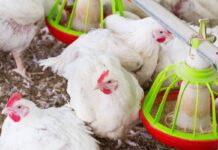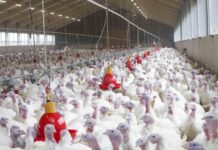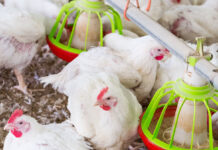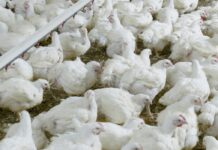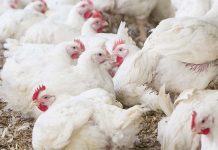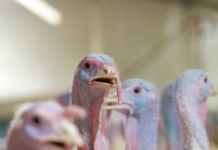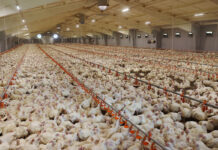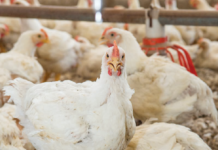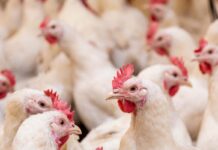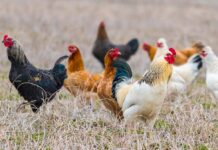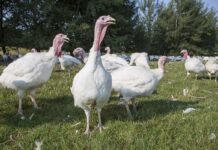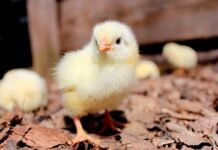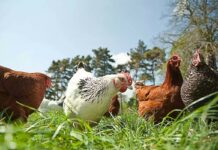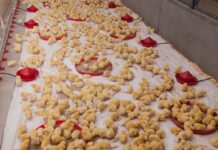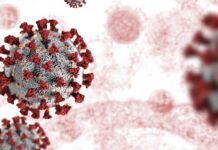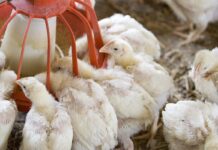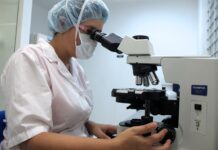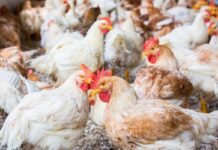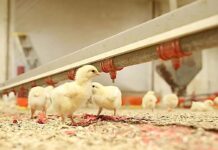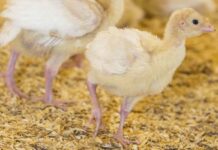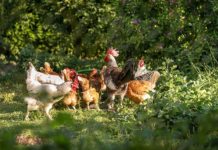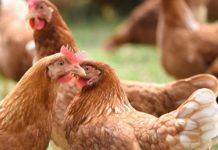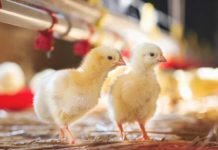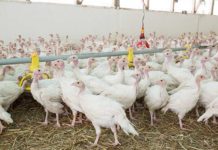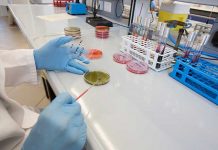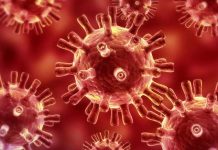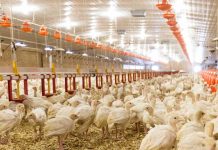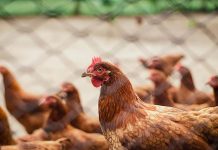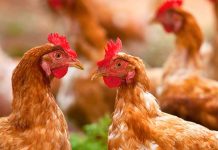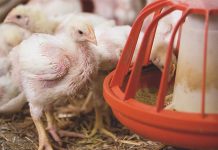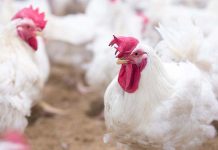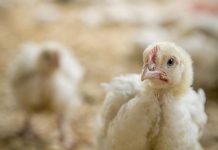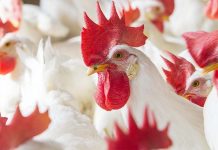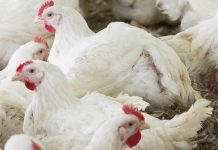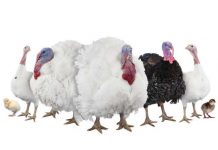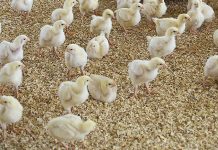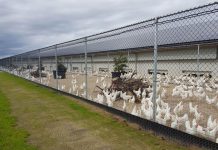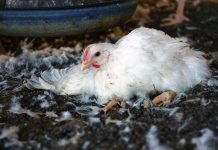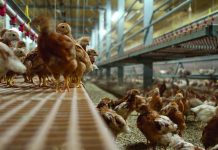Infectious Laryngotracheitis (ILT) Advisory – City of Kingston
The Feather Board Command Centre (FBCC) is issuing an Infectious Laryngotracheitis (ILT) biosecurity advisory for an approximate 10 km area in the City of Kingston.
FBCC...
Better for birds, the earth, and you: Kipster’s egg
In the United States, as of March 2024, 40% of eggs produced are cage-free. While the cage-free movement has gained momentum worldwide, one company...
Incorporating an essential oil and saponin blend as part of an effective coccidiosis management...
Coccidiosis continues to be a top challenge in the poultry industry and growing evidence of reduced sensitivity to traditional anticoccidials like ionophores and chemicals...
Concurrent infection of Histomonas meleagridis and Eimeria meleagridis in a turkey flock
Blackhead disease (histomoniasis) in turkeys is one of the protozoan diseases sporadically documented in commercial turkey production facilities. Histomoniasis may induce mild, moderate, or...
Clinical coccidiosis in broilers with concurrent infection of Eimeria maxima and Eimeria praecox
Coccidiosis is a complex disease in chickens caused by protozoan parasites in the genus Eimeria. As Eimeria species are ubiquitous in poultry facilities, coccidiosis...
Pathological manifestations of highly pathogenic and predominant Eimeria species in turkeys
Coccidiosis is caused by intra-cellular enteric protozoan parasites of the genus Eimeria. Eimeria is a gastrointestinal parasite with a complex life cycle involving an...
Cecal coccidiosis in turkeys
Cecal coccidiosis is an important disease that affects the cecal integrity of turkeys and may result in watery feces with flecks of blood. In...
Poultry gut health critical to NAE production
The production of “No Antibiotics Ever” (NAE) poultry is a common trend worldwide today. Despite scientific evidence indicating that specific antibiotic growth promoters (AGP)...
Overcoming challenges of antibiotic-free production
Antibiotic use once became a conventional, on-farm practice to prevent health issues and boost growth in poultry. Yet, public health concerns about rising bacteria...
Case report: histomoniasis in broiler breeder pullets
Histomoniasis, commonly known as blackhead disease, is caused by an anerobic protozoan parasite, Histomonas meleagridis. Histomoniasis affects all gallinaceous birds and turkeys are the...
Histopathological evaluation of Histomonas meleagridis on ceca and the bursa of Fabricius in turkeys
Histomoniasis is caused by Histomonas meleagridis, a flagellated protozoan parasite. It causes systemic infection in turkeys and induces characteristic lesions in ceca and liver....
Detection of antibodies against Chlamydia species in chicken serum
Avian chlamydiosis is a bacterial infection caused by Chlamydia bacteria. The currently available tests distinguish Chlamydia species based on genetic material. Researchers from Wageningen...
Biological control of Salmonella in the poultry industry: a European perspective
Salmonella remains one of the most important foodborne bacterial pathogens worldwide, and is frequently linked with the consumption of contaminated poultry meat and eggs....
Gut health in poultry production: why, what and how
Gut health has become a dominant topic in the global poultry industry. But why did the topic emerge to become so important to the...
Enumeration of Ascaridia Galli eggs in chicken excreta
Excreta counting techniques in eggs can provide valuable information for assessing flock infection levels, selecting nematode resistant chicken breeds and for determining anthelmintic efficacy.
Although...
Pirbright’s new Avian Influenza vaccine
An improved poultry influenza vaccine has been developed by researchers from The Pirbright Institute. The potential vaccine triggers a rapid immune response which protects...
Protozoal management in turkeys
The two turkey protozoa that cause significant animal welfare and economic distress include various Eimeria species of coccidia and Histomonas meleagridis. For coccidia, oral...
Increased cecal butyrate concentrations protect against Salmonella Enteritidis
Butyrate is a molecule that is extensively studied as a feed additive to improve gut health and animal performance. It also has been described...
A review of novel biological alternatives to antibiotic therapies in poultry
As poultry producers in Australia continue to limit antibiotic use, increasing numbers of alternative therapies and chemical biosecurity products are being used to overcome...
Key global health issues in cage-free and organic laying hens
In USA and Europe there has been a growth in cage-free, free range, and organic production over the last 10 years.
The percentage of all...
Coccidiosis control in broiler breeders with the use of vaccines by Aviagen®
Coccidiosis is a disease of the intestinal lining, produced by the invasion of the mucosal cells by a very prolific protozoan parasite of the...
Infectious Coryza in vaccinated layers: are vaccines failing to protect?
During 2017 and 2018 Infectious Coryza was detected in several commercial vaccinated egg layer flocks in California. The Avibacterium paragallinarum strains isolated from infected...
How to guard your hatchery against biosecurity threats
Biosecurity, by simple definition, is a set of procedures undertaken to limit the spread of infectious pathogens to a susceptible population. It is, however,...
In-ovo corticosterone alters body composition in 35 day old chi-cken meat birds
Increasing evidence suggests early-life exposure to maternal stress can permanently alter thedevelopment of an embryo. Such findings have significant application to the chicken meat...
Pathogenesis of egg infections by salmonella – Second Part
Early protection has been demonstrated after primary live vaccine administration early post-hatch but this effect is serotype-specific, while cross-protection between some serotypes has been...
Interrupting cholesterol pathway reduces Marek’s disease spread
In a new discovery, scientists from The Pirbright Institute confirm that cholesterol production and transport play a crucial role in how Marek’s disease virus...
Turkey arthritis reovirus. Diagnostic strategies
Avian reoviruses (ARVs). They are non-enveloped viruses of 70-80 nm size having an icosahedral symmetry. The viral genome has 10 segments of double stranded...
Mycoplasma Synoviae, a technical update
Mycoplasma are the smallest free-living organisms both in size and number of genes, and unlike many other bacteria, they do not have a cell...
Adaptability of bird flu poses threat to poultry
New insights from a study of the 2016/17 bird flu outbreak show how highly pathogenic bird flu viruses – which are likely to cause...
Researchers characterize selected variant Avian Reovirus strains
USPOULTRY and the USPOULTRY Foundation announce the completion of a funded research project at the University of California, Davis, in which researchers looked to...
Avian reovirus, molecular characterization
Avian reovirus (ARV) is the main cause of viral arthritis and tenosynovitis in chickens and turkeys, triggering economic losses in the poultry industry due...
Role of dietary calcium in Necrotic Enteritis development and pathogenesis
USPOULTRY and the USPOULTRY Foundation announce the completion of a funded research project at Texas A&M University in College Station, Texas, in which the...
Pathogenesis of egg infections by Salmonella – First Part
Salmonella is an invasive bacterial genus and colonizes the gut of chickens, and systemically spreads to internal organs, including the reproductive tract, potentially leading...
The effects of diet and epigenetic alterations on the gut microbiome, inflammation and poultry...
The gut microbiota is a fundamental force influencing diverse aspects of avian physiology. Microbiome studies are at a critical juncture and facing a challenging...
Infectious bronchitis virus shuts down cell stress signals
A new study from scientists at The Pirbright Institute and collaborators at the University of Surrey provides evidence that infectious bronchitis virus (IBV) can regulate the...
Towards practical methods for assessing ILTV vaccine take
In response to ILTV outbreaks, live vaccines are typically administered at 7-14 days of age in drinking water via nipple drinkers which may not...
Researchers examine the role of APEC in turkey cellulitis
USPOULTRY and the USPOULTRY Foundation announce the completion of a funded research project at the University of Georgia in Athens, Georgia, in which researchers...
Infectious bursal disease viruses may swap genetic material during infection
Live cell imaging has been used by researchers at The Pirbright Institute to reveal new information about how different strains of infectious bursal disease virus...
Chicken study probes resistance to food bug
Receiving gut microbes from resistant chickens does not lessen chickens’ susceptibility to bacterium that causes food poisoning.
Susceptible chickens became even more susceptible to Campylobacter,...
Research examines novel next generation sequencing techniques
USPOULTRY and the USPOULTRY Foundation announce the completion of a funded research project at the University of Georgia in Athens, Georgia, in which researchers...
Influenza antibodies made by Pirbright reduce disease in chickens
Scientists at The Pirbright Institute have engineered synthetic antibody
molecules that can be administered to poultry to reduce the symptoms of Influenza, as well as...
Prevention and control of biofilm in water line systems as part of biosecurity protocols
This paper does not address
the situations in which the microbiological quality of the water
has been compromised from the beginning; rather, this paper addresses how
drinking...
Footpad dermatitis in market turkey hens. Bird density and bedding material relationships
Lameness
and poor footpad condition can be major issues for meat-type poultry resulting
in their decreased well-being and decreased productivity. A large body of
research exists for...
Get the most from your diagnostic laboratory.
A field perspective.
You notice the
mortality is up this morning in one of your brooder houses. Your first thought
might be “better take some birds to...
Salmonella prevention strategies and influences of sampling method selection
Multiple factors can influence both Salmonella prevalence and diversity of Salmonella serogroups detected from both pre and post-harvest samples. Sampling methodologies vary widely when...
Pirbright’s livestock coronavirus research
The Pirbright Institute is aware that misinformation regarding the Institute and its research is circulating on social media following an outbreak of a new...
Pulmonary Nocardiosis in turkey poults
Nocardiosis is an opportunistic, noncontagious, pyogranulomatous or suppurative disease of domestic animals, wildlife and people. In domestic animals, it causes mastitis, pneumonia (granulomatous lesions...
How do coccidiosis challenges influence lipid digestibility and energy utilisation?
Coccidiosis continues to be one of the most pervasive and economically detrimental diseases in commercial poultry production. Controlling this enteric disease is an even...
The importance of gut microbiota in chickens
Recent expansion in knowledge about the influence of microbiota on health and disease started a major research revolution in the area. Intestinal systems of...
Sample management and handling for diagnostic testing
Diagnostic testing is an important and widely used tool in commercial poultry husbandry. A key to best use of diagnostic testing, is to begin...
Protecting poultry from Avian Influenza
The Avian Influenza season is upon us, but how much do you know about Avian Influenza? Do you know how to protect the birds...
Host and microbial biomarkers for intestinal health and disease in broilers
New tools can be used to determine the gut health status of animals and to predict animal performance or to make a decision whether...
Chlamydia spp. detected in poultry in Piedmont, Italy
Chlamydia spp. are agents of re-emerging infections in poultry worldwide and deserve attention from a public health perspective due to the well-known zoonotic nature...
A diagnostic laboratory perspective for pathogen detection
Detection of infectious diseases can generally be broken down into laboratory detection of the pathogen or detection of the immune response to the pathogen....
Research provides Insight on colonization of broilers by Salmonella
USPOULTRY and the USPOULTRY Foundation announce the completion of a funded research project at Auburn University in Auburn, Alabama, in which researchers were able...
First-Ever Report of antimicrobial ase across U.S. broiler chickens and turkeys
Dramatic antimicrobial usage changes and improved antimicrobial stewardship.
The new report shows dramatic reductions of turkey and broiler chicken antimicrobial use over a five-year timeframe....
A multidisciplinary research approach on Avian Influenza in Italy
The Avian Influenza epidemic of 2016-2017 had been the largest in Europe in more than 10 years. The circulating virus was a Highly Pathogenic...
Antimicrobial drug resistance in poultry. What do we know about risk factors?
There is an increasing amount of published surveillance and diagnostic submissions data, providing information on prevalence and trends of antimicrobial drug use and antimicrobial...
How Necrotic Enteritis affects animal’ welfare and performance
Necrotic Enteritis (NE) affected flocks have poor enteric health and nutrient digestibility leading to decreased performance and increased excretion of nutrients.
Evidence suggests that...
Field vaccination against ILT in broiler chickens: lack of consistency
When vaccination against infectious laryngotracheitis (ILT) is necessary in broiler flocks, mass administration techniques are required due to the sheer numbers of birds involved....
Clostridial Dermatitis
Clostridial Dermatitis is a disease of economic concern in turkeys. Clostridium perfringens and Clostridium septicum have been isolated consistently from dermatitis lesions in turkeys....
Improving birds’ health by refining their intestinal microbiota health and stability
Intestinal systems of living organisms are inhabited by a dense community of microorganisms dominated by bacteria but also containing archea, fungi, protozoa and viruses....
Wooden Breast Disease
The emergence of Wooden Breast Disease in commercial broiler chickens has been associated with significant economic loss in the poultry industry resulting from severe...
Boosting the cell-mediated immunity in chickens post-hatch via pre-hatch delivery of nucleic acids
Respiratory virus infections such as Avian Influenza, infectious laryngotracheitis and infectious bronchitis lead to high morbidity and mortality in chickens globally.
Given the limitations...
Research provides new understanding of ILT vaccines
USPOULTRY and the USPOULTRY Foundation announce the completion of a funded research project at the University of Delaware in Newark, Delaware, in which researchers...
Linear Epitope Mapping of B-cell responses following immunization with Avian Reovirus S1133
Avian reovirus is a causative agents of tenosynovitis and viral arthritis. Commercially available reovirus vaccines do not protect against challenge with emerging variants associated...
Development of Multilocus sequence typing (MLST) for Mycoplasma gallisepticum
Mycoplasma gallisepticum (MG) is the most pathogenic avian mycoplasma species. It affects commercial, non-commercial poultry and wild birds. Current MG sequence typing methods rely...
Comparing two ELISA kits
Here a comparison of two ELISA kits as been made to assess their efficicacy.
Recombinant turkey herpesvirus vaccines (rHVT) are being widely used for...
Gut health
Gut health and the efficient conversion of feed into its basic components for optimal nutrient absorption is vital for both commercial and turkey breeder...
Holistic view of intestinal health in poultry
Intestinal health is necessary to maintain efficient and sustainable gastrointestinal tract (GIT) physiology. The GIT has digestive, absorptive, metabolic, immunological and endocrinological functions.
This means...
Infectious bronchitis virus (IBV) vaccines produced in eggs have unpredictable mutations
Scientists at The Pirbright Institute have shown that infectious bronchitis virus (IBV) vaccines produced in eggs have unpredictable mutations which may be prone to...
Transcriptomic modifications caused by subclinical necrotic enteritis in broiler chickens
Phasing out of in-feed antibiotics in the poultry industry has caused necrotic enteritis (NE) to become a primary concern in commercial poultry production in...
Quality Control Audits of killed vaccination
Vaccination programs for breeders and egg layers include procedures with inactivated vaccines. Killed (inactivated) vaccines are used to prevent disease in the vaccinated bird...
World Veterinary Day – celebrating the value of vaccination
The theme of this year’s World Veterinary Day – celebrated April, 27th – was Value of Vaccination. To celebrate it, some of the vaccinology...
Heat stress causes inhibition of Eimeria replication in broilers
Eimeria infection is one of the most important diseases affecting poultry production, and is characterized by bloody or watery diarrhea, weight loss, poor feed...
Future of coccidiosis management in turkeys
Coccidiosis is a disease that is caused by protozoan parasites that develop within the intestine of most domestic and wild animals and birds. Coccidia...
Advantages and disadvantages of Coccidiosis control programs in poultry
Coccidiosis is a protozoan economic disease of poultry, in which around 80% of losses are due to mortality, reduced weight gain, inefficient feed conversion,...
Gut health in layers
To some extent gut health has not been a focus of commercial pullet and layer flocks unless the problem contributed to a significant mortality...
Backyard poultry flocks Salmonella spp. seroprevalence
As backyard poultry grows as a hobby in the United States there is an increased worry that poultry will become infected with Salmonella spp....
Holistic view of intestinal health in poultry
The intestinal health of poultry has broad implications for the systemic health of birds, animal welfare, the production efficiency of flocks, food safety, and...



